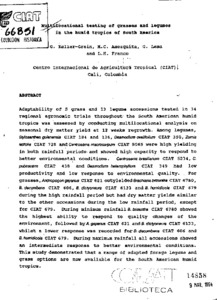Multilocational testing of grasses and legumes in the humid tropics of South America
Adaptability of 5 grass and 13 legume accessions tested in 34 regional agronomic trials throughout the South American humid tropics was assessed by conducting multilocational analysis on seasonal dry matter yield at 12 weeks regrowth. Among legumes, Stylosanthes guianensis CIAT 184 and 136, Desmodium ovalifolium CIAT 350, Zornia latifolia CIAT 728 and Centrosema macrocarpum CIAT 5065 were high yielding in both rainfall periods and showed high capacity to respond to better environmental conditions. Centrosema brasilianum CIAT 5234, C. pubescens CIAT 438 and Desmodium heterophyllum CIAT 349 had low productivity and low response to environmental quality. For grasses, Andropogon gayanus CIAT 621 outyielded Brachiaria brizantha CIAT 6780, B. decumbens CIAT 606, B. dictyoneura CIAT 6133 and B. humidicola CIAT 679 during the high rainfall period but had dry matter yields similar to the other accessions during the low rainfall period, except for CIAT 679. During minimum rainfall B. brizantha CIAT 6780 showed the highest ability to respond to quality changes of the environment, followed by A. gayanus CIAT 621 and B. dictyoneura CIAT 6133, whilst a lower response was recorded for B. decumbens CIAT 606 and B. humidicola CIAT 679. During maximum rainfall all accessions showed an intermediate response to better environmental conditions. This study demonstrated that a range of adapted forage legume and grass options are now available for the South American humid tropics.

